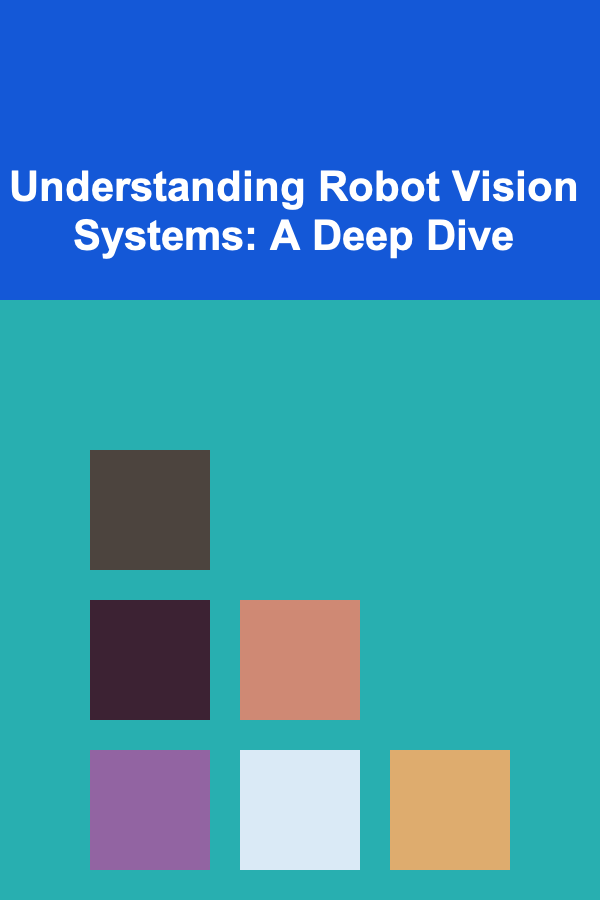
Understanding Robot Vision Systems: A Deep Dive
ebook include PDF & Audio bundle (Micro Guide)
$12.99$7.99
Limited Time Offer! Order within the next:

Robot vision, a subfield of computer vision, is the capability of a robot to "see" its environment. More accurately, it's the process of acquiring, processing, and interpreting images to provide robots with the information they need to perform tasks autonomously. This ability is crucial for robots operating in dynamic and unstructured environments, as it allows them to perceive and react to changes in their surroundings. This article provides a comprehensive exploration of robot vision systems, covering fundamental concepts, key components, algorithms, challenges, and future trends.
I. The Fundamentals of Robot Vision
At its core, robot vision aims to emulate human vision, albeit through artificial means. While human vision is inherently intuitive and efficient, replicating it in a machine requires a structured approach involving several interconnected steps. This section delves into the fundamental concepts that underpin robot vision systems.
A. Image Acquisition: The Foundation of Perception
The first step in robot vision is acquiring images of the environment. This is typically achieved using cameras, but other sensors like LiDAR and depth sensors can also be used, often in conjunction with cameras to provide richer information. The type of camera used depends on the specific application and environmental conditions.
- Monocular Cameras: These are single-lens cameras that capture 2D images. They are simple and cost-effective but lack inherent depth information. Depth can be inferred through techniques like Structure from Motion (SfM) or using machine learning models.
- Stereo Cameras: These consist of two cameras mounted side-by-side, mimicking human binocular vision. By comparing the images from both cameras, depth information can be calculated through triangulation. Stereo vision is generally more robust and accurate than monocular depth estimation.
- Depth Cameras (Time-of-Flight, Structured Light): These cameras actively emit light (either infrared or structured patterns) and measure the time it takes for the light to return or analyze the deformation of the projected pattern. This allows them to directly capture depth information. Time-of-Flight cameras measure the time it takes for a pulse of light to travel to an object and back. Structured Light cameras project a known pattern (e.g., a grid) onto the scene and analyze how the pattern is distorted to infer depth.
- RGB-D Cameras: These cameras combine a standard RGB camera with a depth sensor (e.g., Intel RealSense, Microsoft Kinect). This provides both color and depth information, making them popular for many robotics applications.
- Infrared Cameras (Thermal Cameras): These cameras detect infrared radiation emitted by objects, creating images based on temperature differences. They are useful for tasks like detecting heat signatures, finding people in low-light conditions, and inspecting machinery for overheating.
- Hyperspectral Cameras: These cameras capture images across a wide range of the electromagnetic spectrum, providing detailed information about the material composition of objects. They are used in applications like agriculture, environmental monitoring, and medical imaging.
Beyond the type of camera, other factors influencing image acquisition include:
- Resolution: Higher resolution provides more detail but also increases processing requirements.
- Frame Rate: Higher frame rates allow for faster reaction times but require more computational power and storage.
- Field of View: A wider field of view captures more of the environment but can also introduce distortions.
- Lighting Conditions: Adequate and consistent lighting is crucial for good image quality. Robot vision systems often need to be robust to variations in lighting.
B. Image Processing: Preparing Data for Interpretation
Once an image is acquired, it needs to be processed to remove noise, enhance features, and extract relevant information. Image processing techniques are essential for preparing the data for higher-level analysis.
- Noise Reduction: Images are often corrupted by noise, which can interfere with subsequent processing steps. Common noise reduction techniques include Gaussian blurring, median filtering, and bilateral filtering. Gaussian blurring smooths the image by averaging pixel values, while median filtering replaces each pixel with the median value of its neighbors, effectively removing salt-and-pepper noise. Bilateral filtering preserves edges while smoothing the image.
- Image Enhancement: Techniques like histogram equalization and contrast stretching can improve the visibility of details in the image. Histogram equalization redistributes the pixel intensities to make the image appear more evenly lit, while contrast stretching expands the range of pixel intensities to increase the dynamic range.
- Edge Detection: Identifying edges in an image is crucial for object recognition and segmentation. Popular edge detection algorithms include the Canny, Sobel, and Laplacian operators. The Canny edge detector is known for its accuracy and robustness.
- Thresholding: This technique converts a grayscale image into a binary image by setting pixels above a certain threshold to one value and pixels below to another. Thresholding is useful for segmenting objects from the background. Adaptive thresholding can adjust the threshold based on local image characteristics, making it more robust to varying lighting conditions.
- Morphological Operations: These operations, such as erosion and dilation, can be used to remove small objects or fill in gaps in an image. Erosion shrinks the boundaries of objects, while dilation expands them. These operations are often used in combination to refine image segmentation results.
- Color Space Conversion: Images can be represented in different color spaces, such as RGB, HSV, and LAB. Converting between color spaces can be useful for isolating specific colors or features. For example, HSV (Hue, Saturation, Value) is often used for color-based object detection.
C. Feature Extraction: Identifying Key Characteristics
Feature extraction involves identifying and quantifying salient features in the image that can be used to distinguish between different objects or scenes. These features should be robust to variations in viewpoint, lighting, and scale.
- Keypoint Detectors and Descriptors: Algorithms like SIFT (Scale-Invariant Feature Transform), SURF (Speeded-Up Robust Features), and ORB (Oriented FAST and Rotated BRIEF) detect and describe keypoints in the image. These keypoints are invariant to scale, rotation, and illumination changes, making them suitable for object recognition and tracking. SIFT and SURF are patented and require licensing for commercial use, while ORB is a free and open-source alternative.
- HOG (Histogram of Oriented Gradients): HOG is a feature descriptor that counts occurrences of gradient orientations in localized portions of an image. It is commonly used for object detection, particularly for pedestrian detection.
- Color Histograms: These histograms represent the distribution of colors in an image. They can be used to identify objects based on their color characteristics.
- Texture Features: Texture features describe the patterns and spatial relationships of pixels in an image. Techniques like LBP (Local Binary Patterns) and Gabor filters can be used to extract texture features. LBP is a simple and efficient texture operator that labels pixels based on the values of their neighbors. Gabor filters are a set of bandpass filters that are sensitive to different orientations and frequencies, making them useful for analyzing textures with specific directional properties.
D. Object Recognition and Scene Understanding: Making Sense of the Data
The ultimate goal of robot vision is to enable robots to understand their environment. This involves recognizing objects, understanding their relationships, and interpreting the scene as a whole.
- Classical Machine Learning: Traditional machine learning algorithms like Support Vector Machines (SVMs), Random Forests, and K-Nearest Neighbors (KNN) can be used for object recognition. These algorithms require hand-crafted features and are often less robust to variations in viewpoint and lighting than deep learning methods. However, they can be more computationally efficient and require less training data.
- Deep Learning: Deep learning models, particularly Convolutional Neural Networks (CNNs), have revolutionized object recognition. CNNs automatically learn features from the image data, eliminating the need for hand-crafted features. Popular CNN architectures for object recognition include AlexNet, VGGNet, ResNet, and Inception. Object detection algorithms like Faster R-CNN, YOLO (You Only Look Once), and SSD (Single Shot MultiBox Detector) use CNNs to detect and localize objects in an image. These algorithms can achieve high accuracy and real-time performance.
- Semantic Segmentation: Semantic segmentation assigns a label to each pixel in the image, classifying each pixel into a specific category (e.g., road, building, person). This provides a more detailed understanding of the scene compared to object detection. Fully Convolutional Networks (FCNs) and U-Net are popular architectures for semantic segmentation.
- Instance Segmentation: Instance segmentation extends semantic segmentation by not only classifying each pixel but also distinguishing between different instances of the same object. For example, it can identify each individual car in an image. Mask R-CNN is a popular algorithm for instance segmentation.
- 3D Scene Reconstruction: Using data from multiple cameras or depth sensors, it is possible to reconstruct a 3D model of the environment. This 3D model can be used for navigation, planning, and object manipulation. Techniques like Structure from Motion (SfM) and SLAM (Simultaneous Localization and Mapping) are used for 3D scene reconstruction. SLAM allows a robot to build a map of its environment while simultaneously localizing itself within the map.
II. Key Components of a Robot Vision System
A complete robot vision system involves more than just cameras and algorithms. It encompasses various hardware and software components working in synergy. Understanding these components is essential for designing and implementing effective robot vision solutions.
A. Hardware Components
- Cameras and Sensors: As discussed earlier, the choice of camera depends on the specific application. Factors to consider include resolution, frame rate, field of view, and the type of data required (e.g., RGB, depth, thermal). Sensors like LiDAR (Light Detection and Ranging), which provides highly accurate 3D point clouds, are often used in conjunction with cameras for tasks like autonomous navigation. IMUs (Inertial Measurement Units) can provide information about the robot's orientation and acceleration, which can be used to improve the accuracy of vision-based algorithms.
- Processing Unit: The processing unit is responsible for running the image processing and computer vision algorithms. This can range from a standard CPU to a high-performance GPU (Graphics Processing Unit) or a dedicated embedded system. GPUs are particularly well-suited for deep learning tasks due to their parallel processing capabilities. Embedded systems offer a balance between performance and power consumption, making them suitable for mobile robots. FPGAs (Field-Programmable Gate Arrays) can also be used for accelerating specific image processing algorithms.
- Robotic Platform: The robotic platform provides the physical structure and mobility for the robot. This can range from a simple wheeled robot to a complex humanoid robot or a robotic arm. The robotic platform must be able to move the camera and other sensors to capture the desired views of the environment. The platform should also provide a stable base for the sensors to minimize vibrations and ensure accurate data acquisition.
- Actuators: Actuators are responsible for executing the actions planned by the robot. These can include motors, servos, and pneumatic or hydraulic cylinders. The accuracy and speed of the actuators are critical for the robot's performance. The control system must be able to coordinate the actuators based on the information provided by the vision system.
B. Software Components
- Image Acquisition Libraries: These libraries provide interfaces for accessing and controlling the cameras and sensors. Examples include OpenCV (Open Source Computer Vision Library), which provides a wide range of functions for image processing and computer vision, and vendor-specific SDKs (Software Development Kits) for specific cameras.
- Image Processing and Computer Vision Libraries: These libraries provide the algorithms for processing images, extracting features, and recognizing objects. OpenCV is a widely used library that provides a comprehensive set of functions for image processing, feature detection, object tracking, and machine learning. Other libraries include scikit-image, which provides a collection of algorithms for image processing and analysis, and SimpleITK, which is designed for medical image analysis.
- Machine Learning Frameworks: These frameworks provide tools for building and training machine learning models. TensorFlow, PyTorch, and Keras are popular deep learning frameworks that provide high-level APIs for building and training neural networks. Scikit-learn is a popular library for classical machine learning algorithms.
- Robot Operating System (ROS): ROS is a flexible framework for writing robot software. It provides a collection of tools, libraries, and conventions that simplify the task of building complex robot systems. ROS supports a wide range of programming languages, including C++, Python, and Java. It also provides a mechanism for communication between different software components running on different computers.
- Planning and Control Software: This software uses the information provided by the vision system to plan and execute actions. This involves tasks like path planning, motion control, and task scheduling. The planning and control software must be able to handle uncertainty and adapt to changes in the environment.
III. Algorithms for Robot Vision
Robot vision relies on a wide range of algorithms to perform various tasks. This section provides an overview of some of the key algorithms used in robot vision systems.
A. SLAM (Simultaneous Localization and Mapping)
SLAM is a fundamental algorithm for enabling robots to navigate in unknown environments. It allows a robot to build a map of its surroundings while simultaneously localizing itself within the map. SLAM algorithms typically use data from cameras, LiDAR, and IMUs to estimate the robot's pose and the structure of the environment.
- Visual SLAM (VSLAM): VSLAM uses images from cameras to build a map of the environment. It relies on feature extraction and matching to track the robot's movement and estimate the 3D structure of the scene. ORB-SLAM is a popular VSLAM algorithm that is known for its accuracy and robustness.
- LiDAR SLAM: LiDAR SLAM uses point clouds from LiDAR sensors to build a map of the environment. LiDAR provides highly accurate depth information, making it suitable for building detailed 3D maps. LOAM (LiDAR Odometry and Mapping) is a popular LiDAR SLAM algorithm.
- Sensor Fusion SLAM: Sensor fusion SLAM combines data from multiple sensors, such as cameras, LiDAR, and IMUs, to improve the accuracy and robustness of the SLAM system. The Extended Kalman Filter (EKF) and the Particle Filter are commonly used for sensor fusion.
B. Object Detection and Recognition
Object detection and recognition are crucial for enabling robots to interact with their environment. Object detection algorithms identify the location of objects in an image, while object recognition algorithms classify the objects into different categories.
- Classical Object Detection: Algorithms like Haar cascades and HOG with SVMs were commonly used for object detection before the advent of deep learning. Haar cascades are used for face detection and are based on the computation of Haar-like features, which are simple rectangular features that capture differences in pixel intensities. HOG (Histogram of Oriented Gradients) is a feature descriptor that counts occurrences of gradient orientations in localized portions of an image. SVMs (Support Vector Machines) are used to classify the extracted features.
- Deep Learning-Based Object Detection: CNN-based object detection algorithms, such as Faster R-CNN, YOLO, and SSD, have achieved state-of-the-art performance. Faster R-CNN uses a region proposal network (RPN) to generate candidate object regions, which are then classified by a CNN. YOLO (You Only Look Once) is a single-stage object detector that predicts bounding boxes and class probabilities directly from the input image. SSD (Single Shot MultiBox Detector) is another single-stage object detector that uses multiple feature maps to detect objects at different scales.
C. Object Tracking
Object tracking involves following the movement of an object over time. This is essential for tasks like robot manipulation and surveillance.
- Kalman Filter: The Kalman filter is a recursive algorithm that estimates the state of a dynamic system from a series of noisy measurements. It is commonly used for tracking objects in video sequences.
- Particle Filter: The particle filter is a Monte Carlo method that represents the state of the system as a set of particles. Each particle represents a possible state of the object being tracked. The particle filter is more robust to non-linearities and non-Gaussian noise than the Kalman filter.
- Mean Shift: Mean shift is a non-parametric algorithm that iteratively shifts a window to the region of highest density. It is commonly used for tracking objects with complex shapes and appearances.
- Deep Learning-Based Tracking: Deep learning models can also be used for object tracking. Siamese networks are commonly used for tracking objects by learning a similarity metric between the target object and the search region. These networks are trained to discriminate between the target object and distractors in the scene.
D. Path Planning
Path planning involves finding a collision-free path for the robot to move from one location to another. This is essential for autonomous navigation.
- A Algorithm:* The A* algorithm is a graph search algorithm that finds the shortest path between two nodes in a graph. It uses a heuristic function to estimate the distance to the goal node, which helps to guide the search.
- RRT (Rapidly-exploring Random Tree): RRT is a sampling-based algorithm that builds a tree of possible paths by randomly sampling points in the environment. It is well-suited for high-dimensional configuration spaces.
- Potential Fields: Potential fields create a virtual force field around the robot, where the goal location exerts an attractive force and obstacles exert repulsive forces. The robot moves along the path of steepest descent in the potential field.
IV. Challenges in Robot Vision
Despite the significant advancements in robot vision, several challenges remain. Addressing these challenges is crucial for realizing the full potential of robot vision systems.
A. Illumination Variation
Changes in lighting conditions can significantly affect the performance of robot vision algorithms. Algorithms need to be robust to variations in illumination, such as shadows, highlights, and changes in color temperature.
- Solutions: Using adaptive thresholding techniques, histogram equalization, and color constancy algorithms can help to mitigate the effects of illumination variation. Deep learning models can also be trained to be more robust to illumination changes by using data augmentation techniques that simulate different lighting conditions. HDR (High Dynamic Range) cameras can capture a wider range of light intensities, providing more robust images in varying lighting conditions.
B. Occlusion
Occlusion occurs when objects are partially or completely hidden from view. This can make it difficult to detect and recognize objects.
- Solutions: Using multiple cameras from different viewpoints can help to reduce the effects of occlusion. Object tracking algorithms can be used to maintain a track of objects even when they are temporarily occluded. Deep learning models can be trained to infer the presence of occluded objects based on the visible parts of the object. 3D object recognition techniques can be used to estimate the pose and shape of occluded objects.
C. Clutter and Complexity
Real-world environments are often cluttered and complex, making it difficult to segment and understand the scene. The presence of many objects and background clutter can confuse robot vision algorithms.
- Solutions: Using semantic segmentation algorithms can help to classify different regions of the image, which can make it easier to distinguish between objects and background clutter. Deep learning models can be trained to filter out irrelevant information and focus on the objects of interest. Using depth information from depth cameras or LiDAR can help to separate objects from the background. Contextual information, such as the surrounding environment and the task being performed, can be used to improve the accuracy of object recognition.
D. Real-Time Performance
Many robotics applications require real-time performance, meaning that the robot vision system must be able to process images and make decisions quickly enough to respond to changes in the environment. Achieving real-time performance can be challenging, especially for complex algorithms.
- Solutions: Using optimized algorithms and hardware acceleration can help to improve the performance of robot vision systems. GPUs and FPGAs can be used to accelerate computationally intensive tasks, such as deep learning inference. Reducing the resolution of the images can also help to improve performance, but this may come at the cost of accuracy. Using parallel processing techniques can allow multiple tasks to be performed simultaneously. Model compression techniques, such as quantization and pruning, can be used to reduce the size and complexity of deep learning models, making them faster to execute.
E. Generalization
Robot vision systems need to be able to generalize to new environments and objects that they have not seen before. This requires training the system on a large and diverse dataset.
- Solutions: Using data augmentation techniques can help to increase the size and diversity of the training dataset. Transfer learning, where a model trained on a large dataset is fine-tuned on a smaller dataset for a specific task, can improve the generalization performance. Domain adaptation techniques can be used to adapt a model trained on one domain (e.g., simulated images) to another domain (e.g., real images). Using unsupervised or self-supervised learning techniques can allow the system to learn from unlabeled data.
V. Future Trends in Robot Vision
The field of robot vision is constantly evolving, with new technologies and algorithms emerging all the time. This section highlights some of the key future trends in robot vision.
A. Deep Learning and AI
Deep learning will continue to play a dominant role in robot vision. Advancements in deep learning architectures, training techniques, and hardware acceleration will lead to more accurate, robust, and efficient robot vision systems. The integration of other AI techniques, such as reinforcement learning and generative adversarial networks (GANs), will further enhance the capabilities of robot vision systems.
B. Edge Computing
Edge computing involves processing data closer to the source, rather than sending it to a remote server. This can reduce latency, improve security, and reduce bandwidth consumption. Edge computing will become increasingly important for robot vision systems, allowing robots to process images and make decisions in real-time, even in environments with limited connectivity.
C. Sensor Fusion
Sensor fusion involves combining data from multiple sensors to create a more complete and accurate understanding of the environment. Sensor fusion will become increasingly important for robot vision systems, as it can improve robustness to noise, occlusion, and other challenges. The development of new sensor fusion algorithms and hardware will enable robots to perceive their environment more accurately and reliably.
D. 3D Vision
3D vision will become increasingly important for robotics applications, as it provides a more complete and accurate representation of the environment than 2D vision. Advancements in depth sensing technologies, such as LiDAR and structured light, will lead to more accurate and affordable 3D vision systems. 3D vision will enable robots to perform more complex tasks, such as object manipulation, navigation, and inspection.
E. Explainable AI (XAI)
As robot vision systems become more complex and rely on deep learning models, it is important to understand how these systems make decisions. Explainable AI (XAI) techniques aim to provide insights into the reasoning process of AI models, making them more transparent and trustworthy. XAI will become increasingly important for robot vision systems, as it can help to identify biases, debug errors, and improve the overall performance of the system.
F. Human-Robot Collaboration
Robot vision will play a crucial role in enabling safe and effective human-robot collaboration. Robot vision systems can be used to detect and track humans in the environment, predict their intentions, and adapt the robot's behavior accordingly. This will allow robots to work alongside humans in a variety of settings, such as manufacturing, healthcare, and logistics.

How to Find Financial Resources for Entrepreneurs
Read More
How to Save Time While Running Multiple Errands in One Trip
Read More
How to Understand the Basics of Stock Market Investing
Read More
How to Use Dollar-Cost Averaging to Build Wealth
Read More
How to Navigate Crypto Regulations
Read More
Exploring the Folk Revival of the 1960s: A Deep Dive
Read MoreOther Products

How to Find Financial Resources for Entrepreneurs
Read More
How to Save Time While Running Multiple Errands in One Trip
Read More
How to Understand the Basics of Stock Market Investing
Read More
How to Use Dollar-Cost Averaging to Build Wealth
Read More
How to Navigate Crypto Regulations
Read More